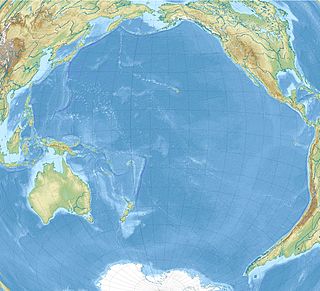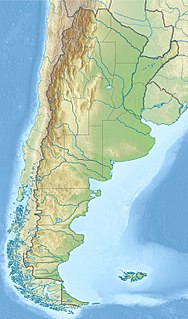
A volcano is a rupture in the crust of a planetary-mass object, such as Earth, that allows hot lava, volcanic ash, and gases to escape from a magma chamber below the surface.

Mount Waesche is a mountain of volcanic origin at the southern end of the Executive Committee Range in Marie Byrd Land, Antarctica. It is 3,292 metres high, and stands 20 kilometres southwest of Mount Sidley, the highest volcano in Antarctica. The mountain lies southwest of the Chang Peak caldera and is largely covered with snow and glaciers, but there are rock exposures on the southern and southwestern slopes.

Pico do Fogo[ˈpiku du ˈfoɡu] is the highest peak of Cape Verde and West Africa, rising to 2,829 metres (9,281 ft) above sea level. It is an active stratovolcano lying on the island of Fogo. The main cone last erupted in 1680, causing mass emigration from the island. A subsidiary vent erupted in 1995. The only deadly eruption was in 1847 when earthquakes killed several people.

Cerro Azul, sometimes referred to as Quizapu, is an active stratovolcano in the Maule Region of central Chile, immediately south of Descabezado Grande. Part of the South Volcanic Zone of the Andes, its summit is 3,788 meters (12,428 ft) above sea level, and is capped by a summit crater that is 500 meters (1,600 ft) wide and opens to the north. Beneath the summit, the volcano features numerous scoria cones and flank vents.

San Pedro is a Holocene composite volcano in northern Chile and one of the tallest active volcanoes in the world. Part of the Chilean Andes' volcanic segment, it is part of the Central Volcanic Zone of the Andes, one of the four tracts of the Andean Volcanic Belt. This region of volcanism includes the world's two highest volcanoes Ojos del Salado and Llullaillaco. San Pedro, like other Andean volcanoes, was formed by the subduction of the Nazca Plate beneath the South America Plate. It has a neighbouring volcano, San Pablo, and is itself formed by two separate edifices usually known as the Old Cone and the Young Cone. These edifices are formed by rocks ranging from basaltic andesite over andesite to dacite and are emplaced on a basement formed by Miocene volcanic rocks.

Tatun Volcanoes, a volcanic group of volcanoes located in northern Taiwan, is located 15 km north of Taipei, and lies to the west of Keelung. It just adjoins the northern coast of the Taiwan island. The volcano group was a result of episodic volcanism between 2.8 and 0.2 Ma. As of 2005, some geothermal activity was occurring and gas fumaroles were active among these volcanoes. Observations on Tatun Volcano Group suggest that magma chambers probably still exist under the land surface of northern Taiwan.

The hydrothermal vents and seamounts of the Azores are a series of Atlantic seamounts and hydrothermal vents that are part of the Mid-Atlantic Ridge system, giving rise to the archipelago and bathymetric region of the Azores. These geological structures, formed from masses of basalt, are of a geomorphological interest due to their rich deposits of ore. In addition it fosters a rich ecosystem of diverse subaquatic plant and animal life. There are food chains within this environment, for example, that are purely chemosynthetic, and do not need sunlight for photosynthesis.

The Andagua volcanic field is a volcanic field in southern Peru which includes a number of cinder cones, lava domes and lava flows which have filled the Andagua Valley. The volcanic field is part of a larger volcanic province that clusters around the Colca River and is mostly of Pleistocene age, although the Andagua sector also features volcanic cones with historical activity, with the last eruption about 370 years ago. Eruptions were mostly effusive, generating lava flows, cones and small eruption columns. Future eruptions are possible, and there is ongoing fumarolic activity. Volcanic activity in the field has flooded the Andahua valley with lava flows, damming local watersheds in the Laguna de Chachas, Laguna Mamacocha and Laguna Pumajallo lakes and burying the course of the Andagua River. The Andahua valley segment of the larger volcanic province was declared a geopark in 2015.

Lastarria is a stratovolcano that lies on the border between Chile and Argentina. It is part of the Central Volcanic Zone, one of the four segments of the volcanic arc of the Andes. Several volcanoes are located in this chain of volcanoes, which is formed by subduction of the Nazca Plate beneath the South American Plate.

Olca-Paruma is a volcanic complex in Chile. Lying on the border between Chile and Bolivia, it is formed by an east-west alignment of volcanoes. From west to east, these are Cerro Paruma, Volcan Paruma, Olca, and Mencheca or Michincha. Aside from the mines of Ujina, Rosario, and Quebrada Blanca, the area is sparsely populated.

The Honolulu Volcanics are a group of volcanoes which form a volcanic field on the island of Oʻahu, Hawaiʻi, more specifically in that island's southeastern sector and in the city of Honolulu from Pearl Harbor to the Mokapu Peninsula. It is part of the rejuvenated stage of Hawaiian volcanic activity, which occurred after the main stage of volcanic activity that on Oʻahu built the Koʻolau volcano. These volcanoes formed through dominantly explosive eruptions and gave rise to cinder cones, lava flows, tuff cones and volcanic islands. Among these are well known landmarks such as Diamond Head and Punchbowl Crater.

South Arch volcanic field is an underwater volcanic field south of Hawaiʻi Island. It was active during the last 10,000 years, and covers an area of 35 by 50 kilometres at a depth of 4,950 metres (16,240 ft).

North Arch volcanic field is an underwater volcanic field north of Oahu, Hawaii. It covers an area of about 25,000 square kilometres (9,700 sq mi) and consists of large expanses of alkali basalt, basanite and nephelinite that form extensive lava flows and volcanic cones. Some lava flows are longer than 100 kilometres (62 mi).

NW Rota-1 is a seamount in the Mariana Islands, northwest of Rota, which was discovered through its hydrothermal activity in 2003. The volcano has been observed to be erupting underwater, the first time that submarine explosive eruptions have been directly witnessed.

Cadamosto Seamount is a seamount in the Cape Verde islands, 25 kilometres (16 mi) southwest of Brava. It rises to a depth of 1,380 metres (4,530 ft) and partially overlaps with Brava. The seamount appears to be one of the recently active volcanic centres of the Cape Verde islands and has produced phonolite. The seamount has had intense volcanic eruptions in the late Pleistocene, and recent seismic activity indicates that volcanism is ongoing.

Coral Patch Seamount is a seamount between Madeira and Portugal in the North Atlantic Ocean. It is an elongated 120 kilometres (75 mi) long and 70 kilometres (43 mi) wide mountain that rises to a depth of about 645 metres (2,116 ft), with nine volcanic cones on its summit. It has steeper southern slopes and a gentle northern slope. To its west lies Ampére Seamount, and together with several neighbouring seamounts it is one of the Horseshoe Seamounts.

Pasto Ventura is an area in the Catamarca Province of Argentina. It features about 14 small Pleistocene volcanoes, mostly cinder cones with associated lava flows but also lava domes, tuff rings and two maars. The volcanoes are accompanied by pyroclastic deposits and their total volume reaches about 0.42 cubic kilometres (0.10 cu mi). Argon-argon dating has yielded ages ranging from 1.3 million years to about 270,000 years for volcanic rocks in the field.

Henry Seamount is a seamount of Cretaceous age southeast of El Hierro in the Canary Islands. It is 660 metres (2,170 ft) high above the seafloor and covered with sediments. Despite its old age, it shows evidence of recent eruptions and of hydrothermal activity in the last 3,350 years. This activity may be either mediated by groundwater flow from El Hierro or by recent eruptions of Henry Seamount.

The island of La Palma in the Canary Islands is at risk of undergoing a large landslide, which could cause a tsunami in the Atlantic Ocean. Volcanic islands and volcanoes on land frequently undergo large landslides/collapses, which have been documented in Hawaii for example. A recent example is Anak Krakatau, which collapsed to cause the 2018 Sunda Strait tsunami, claiming hundreds of lives.



















